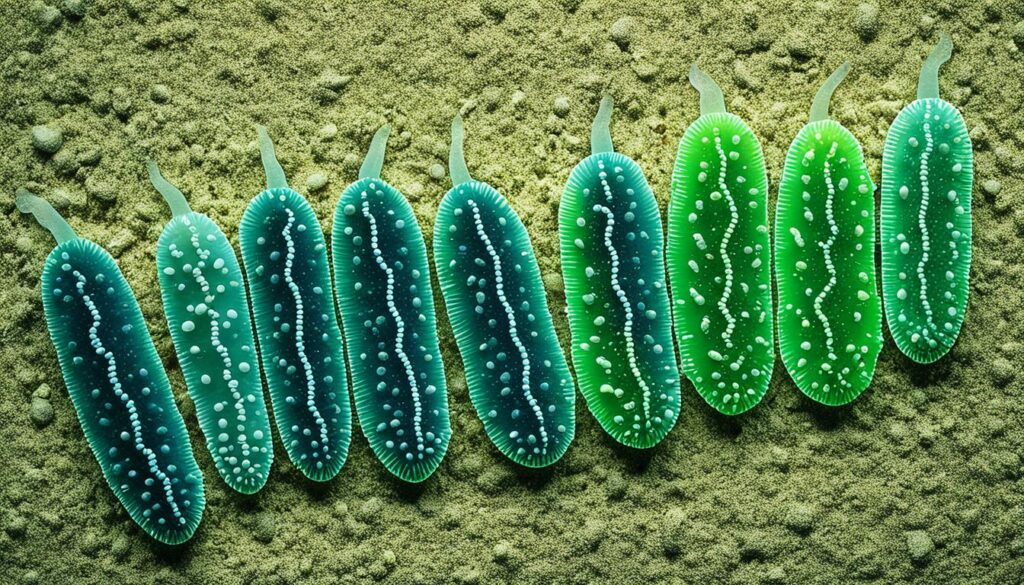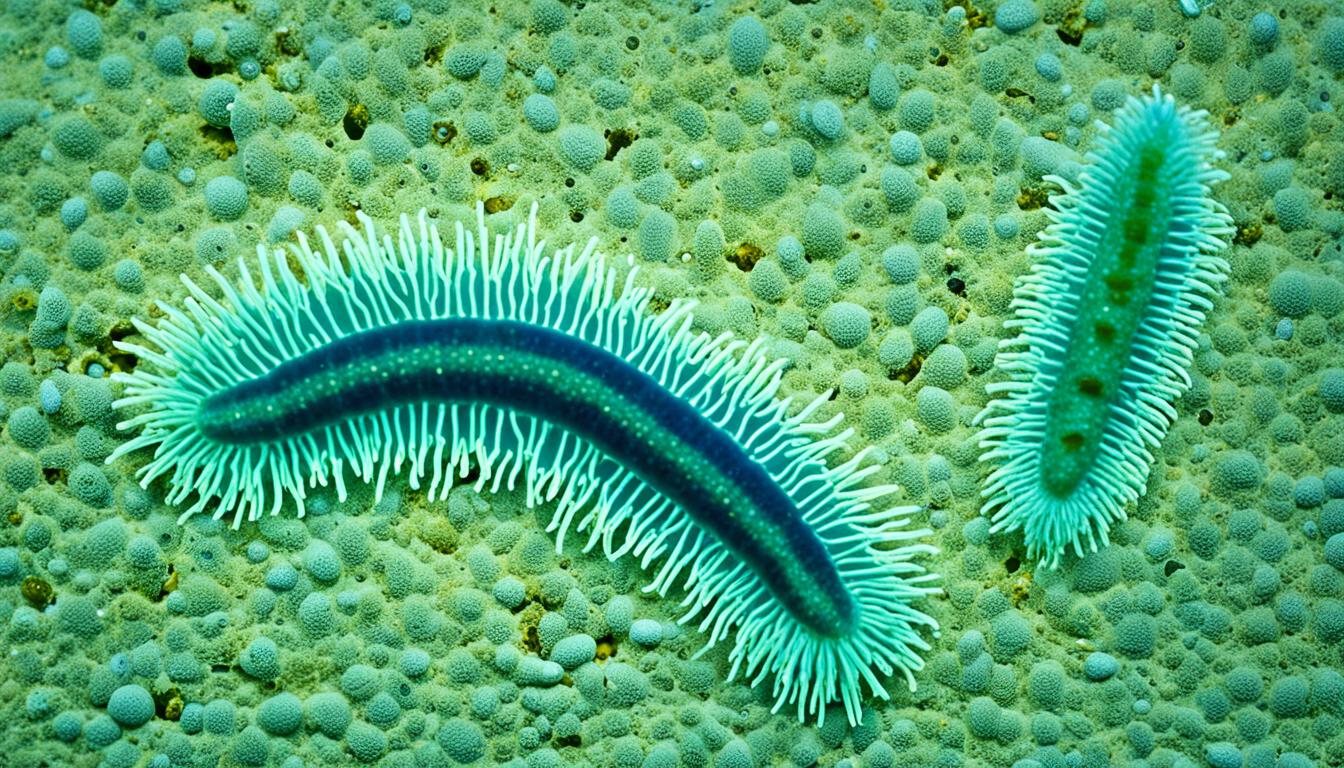Sea cucumbers have a fascinating way of reproducing. They belong to the echinoderm family, which also includes sea stars and sea urchins. Their unique breeding habits are key to their survival and growth. Let’s dive into how they reproduce and what affects their breeding.
Introduction to Sea Cucumbers and Their Habitats
Sea cucumbers are fascinating creatures that play a vital role in marine ecosystems. They are important for the health of the ocean. By learning about them, we can understand their role in nature.
What are Sea Cucumbers?
Sea cucumbers belong to the class Holothuroidea and are soft-bodied echinoderms. They live in oceans all over the world. These creatures are not vegetables but are a key part of the ocean’s life.
They have a unique shape and skin that feels like leather. This makes them stand out from other sea creatures.
Diversity and Size Range of Sea Cucumbers
There are over 1,000 types of sea cucumbers, showing their amazing diversity. Their sizes vary greatly, from just four inches to over ten feet long. This size range lets them live in many different places.
Natural Habitats and Feeding Behavior
Sea cucumbers live in many places, like coral reefs, sandy bottoms, and seagrass beds. These places are perfect for them because they have lots of food. They eat algae and dead plants and animals.
They help the ocean by recycling nutrients and filtering the water. This keeps the ocean healthy.
Understanding Sea Cucumber Reproduction
Sea cucumbers have two main ways to reproduce, each with its own purpose. These methods help keep their populations stable and increase genetic diversity. By learning about these reproduction types, we can understand how they survive and fit into their ecosystems.
Types of Reproduction in Sea Cucumbers
Sea cucumbers reproduce through sexual and asexual methods. Sexual reproduction, or broadcast spawning, means they release eggs and sperm into the water at the same time. This leads to fertilization outside the body and helps create diverse offspring. Asexual reproduction, on the other hand, lets one sea cucumber split into two or more identical copies. This way, they can quickly grow their numbers in good living conditions.
Importance of Reproductive Strategies
How sea cucumbers reproduce is key to their survival and growth. Sexual reproduction brings new genes into the mix, helping them adapt to changes. Asexual reproduction, however, lets them quickly fill up an area, which is important for survival in healthy environments. Knowing how sea cucumbers breed helps us protect them and their homes.
| Type of Reproduction | Description | Advantages | Disadvantages |
|---|---|---|---|
| Sexual Reproduction | Broadcast spawning allows the release of gametes into the water for external fertilization. | Increases genetic diversity; adapts to environmental changes. | Depends on synchrony of spawning; may lead to lower survival rates of offspring. |
| Asexual Reproduction | Involves budding or fission to create clones of the parent organism. | Rapid population increase; maintains existing adaptations. | Lacks genetic diversity; more susceptible to disease or environmental shifts. |
How do sea cucumbers reproduce?
Sea cucumbers have two main ways to reproduce: sexual and asexual. These methods show how these marine animals adapt and play a key role in their ecosystem.
Sexual Reproduction Method
Sea cucumbers, like Stichopus chloronotus, use an interesting sea cucumber spawning behavior for sexual reproduction. Males and females release their gametes into the water through a special opening. This happens twice a year, in warmer months, to increase the chances of fertilization.
During spawning, sea cucumbers lift their front ends to release their gametes. These gametes form threads that spread out in the water, leading to fertilization.
Asexual Reproduction through Budding and Fission
Asexual reproduction is another way sea cucumbers reproduce, through budding and fission. Fission is when the sea cucumber splits into two parts, both of which can quickly grow back. This shows how sea cucumbers can recover and thrive in different places.
Here’s a quick look at these two ways of reproducing:
| Reproduction Method | Process Description | Frequency | Benefits |
|---|---|---|---|
| Sexual | Gametes released into water, fertilization occurs externally. | Twice yearly, during warmer months. | Genetic diversity, adaptation to changing environments. |
| Asexual (Fission) | Organism divides into two independent entities through body constriction. | Occurs continuously as needed. | Rapid population increase, resilience against predation. |
The Sea Cucumber Life Cycle
The life of a sea cucumber goes through many phases. These phases help them survive and grow. Knowing about these stages shows us the challenges they face in the ocean.
The developmental stages of sea cucumbers are key to their success. They play a big part in how well they do in their ocean homes.
From Eggs to Larvae: Development Stages
Sea cucumber eggs turn into free-swimming larvae in about three days after fertilization. This larval stage is very important for their survival. Many larvae don’t make it because of predators and tough conditions.
Those that settle on the ocean floor grow into young sea cucumbers. They start to develop important features like tentacles and tube feet at this point.
Growth into Adult Sea Cucumbers
Young sea cucumbers grow into adults over several months. How well they grow depends a lot on their environment. Adults can live five to ten years, which is important for keeping their numbers up.
Learning about the sea cucumber life cycle helps us understand how they can recover and their role in the ocean.

Factors Affecting Sea Cucumber Reproduction
Understanding what affects sea cucumber reproduction is key to their survival. Environmental factors play a big role in their breeding habits. This affects how stable their populations can be.
Environmental Influences on Spawning Behavior
Environmental factors are crucial for sea cucumber reproduction. Important ones include:
- Water Temperature: The right temperature helps them spawn. But extreme changes can stop them from reproducing.
- Salinity Levels: Salinity changes can affect how well their eggs and sperm develop and survive.
- Habitat Quality: A healthy home is needed for successful breeding and growing of their young.
- Seasonal Variability: They usually spawn with the seasons. This shows how important it is to have predictable environmental signs.
Impact of Overfishing and Habitat Loss
Overfishing and destroying their homes really hurt sea cucumber reproduction. These actions lead to:
- Decreased Population Sizes: Fewer sea cucumbers mean less genetic diversity and health for future generations.
- Disruption of Spawning Patterns: Changes in their homes can make them spawn less regularly. This hurts the number of young they have.
- Altered Ecosystems: Taking sea cucumbers out of their homes can mess up the balance in the ocean, affecting other species too.
We need to address these issues to save sea cucumbers and their homes. By managing things sustainably, we can lessen the harm. This helps these important sea creatures and their homes stay strong.
Conservation and Future of Sea Cucumber Populations
Sea cucumbers are facing threats from overfishing and environmental harm. Their numbers are going down because of a big demand for them, especially in Asia. We need to make sure we harvest them in a way that helps them recover and grow.
Teaching people about sea cucumbers is key to saving them. By telling local communities how important these creatures are, we can get them to support saving them. Making sustainable aquaculture a part of local economies can help protect these species and also help people earn money.
To save sea cucumber populations, we all need to work together. By supporting conservation efforts, spreading the word, and pushing for sustainable ways, we help keep marine life diverse and healthy. Helping sea cucucumbers means we’re also looking out for the oceans for the future.










